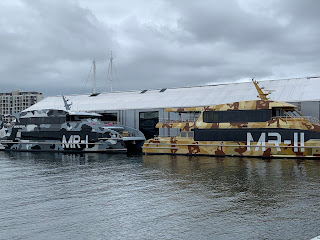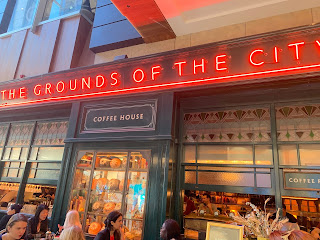Wednesday February 27 was our coldest day of the trip so far and there was rain on and off. High about 14C.
After breakfast, we headed to Olveston Historic Home which is two minutes away on Royal Terrace, the street we are staying on. Olveston was built for Dunedin businessman, collector and philanthropist David Theomin (1852-1933) and was the family home from 1906-1966. The family was Jewish. David Theomin was originally from Bristol England and immigrated to Melbourne in 1874, where he met his future wife, Marie Michaelis (1855-1926). They married in 1879 and moved to Dunedin in 1880. For more than twenty years, Marie and David lived in a house which was on part of the present Olveston site and it was there that they raised their two children. The older house also seems to have been known as Olveston, a town near Bristol. The new house was built between 1904-06. David Theomin had a general importing firm, was active in the Chamber of Commerce, and for much of his Dunedin life, was President of the synagogue.
The Theomins had two children - Edward (1885-1928) and Dorothy (1888-1966). Edward served in WWI and married Ethel Mocatta (1889-1982) in London in 1919. They returned to Dunedin where they lived in a house down the street on Royal Terrace. He died in 1928 from a debilitating virus. They had no children. Ethel, a very independent woman, obtained a B.Sc. Degree in London and worked for a time as an analytical chemist before marrying Edward.
Dorothy never married and was a noted philanthropist and mountaineer. In her will, she gave Olveston and its contents to the City of Dunedin. For a period of time, there was uncertainty as to whether or not the City would accept the gift and it was largely due to the energies of a group of Dorothy's friends that it was accepted as a property fit to become a historic home open to the public.
While took a look at the beautiful gardens as we waiting for our noon tour.
 |
| Plaque outside of home- noting donation of house by Dorothy Theomin |
 |
| One view of home |
 |
| Another side |
 |
| Greenhouse and gardens |
 |
| Lovely gardens |
The family's second car was a 1921 Fiat. The chauffeur ended up with the car (story unclear) and it was found in dilapidated condition in 1994. It has been beautifully restored and sits in the garage. It is even driven occasionally.
 |
| 1921 Fiat-- flowers are the reflection in my camera |
 |
| Garage with car |
The tour was about an hour. The rooms were beautifully preserved and contained all original furniture, art and dishes from the home. There were only a few reproduction carpets in rooms where visitors could walk. The design of the home was beautiful. There was a lot of Japanese art which was very popular in the late 19th and early 20th century. There were great views of the harbour and the two children had lovely sitting rooms and bedrooms. Apparently, David Theomin invested in many state of the art features for the home--- central heating and an elaborate telephone and bell system that ran off electricity (they had an early generator). It was very Downton Abbey. The Butler's room and the kitchen were very spacious. While some of the furniture had been updated by the 1960s, the old furniture was found in storage and the house was redone as it would have looked in the early 20th century.
Our guide pointed out that some of the New Zealand paintings they purchased from local artists are worth more now than some of the English watercolours the Theomins had acquired. The oak used in the house was imported from England, as were the initial servants.
Unfortunately, we were not allowed to take pictures inside the home, but I managed to find a few on the internet, below.
 |
| Outside of the house (internet) |
 |
| With gardens (internet) |
 |
| The family in 1906 (Edward (son) and Marie (mother) in the back and Dorothy (daughter) and David (father) seated) (internet) |
 |
| The kitchen (internet) |
 |
| Library (internet) |
 |
| Drawing room with Steinway piano (internet) |
 |
| Dining room with table set for a dinner party that would have taken place in 1906 (internet) |
 |
| Lots of Japanese art--- stairway going to bedrooms and game room (internet) |
After the tour, we walked into town and had brunch (the New Zealand meal of choice) at Modaks Espresso.
 |
| Outside of Modaks-- too cold to sit out |
 |
| Inside-- one orders and pays at counter and then sits at a table where they bring your food. |
 |
| More street art |
 |
| More.. |
We then went back to the Dunedin Public Art Gallery to see the exhibits on the second floor. The first exhibit we saw was entitled:
New Networks: Contemporary Chinese Art. The exhibit showcased the work of sixteen Chinese artists, who have emerged since the late 1970s. Most, but not all of the work was done since 2000.
 |
Xu Bing (b. 1955 Chinese) In the shadow of the straw bale 1987 -
references the artist's time living in rural China in the 1970s. |
 |
| Song Dong ( b. 1966 Chinese) A Pot of Boiling Water 1995, 2010 [reprint] A series of photographs record Song using steaming water to 'draw' a line along a pavement, a fleeting gesture that endures only through photographic record. There was a lot of performance art done in the period following Tiananmen Square. |
 |
| Pouring the water in the foreground |
 |
| Last photograph--steam will soon disappear |
 |
| Ai WeiWei (b. 1957- Chinese) Sunflower Seeds 2010, Porcelain, White Rabbit Collection, Sydney |
 |
| Huang Yan (b. 1966 Chinese) Brother and Sister 2 2006, White Rabbit Collection, Sydney |
 |
| Liu Jianhua (b. 1962 Chinese) Container Series 2009, Porcelain with celadon and red glaze- 37 pieces, Collection Art Gallery of New South Wales-- unites the historic and contemporary- appearing to brim with a liquid resembling blood |
The second exhibit featured a few works by Yang Yongliang (b. 1980 Chinese) called
Artificial Wonderland.
Artificial Wonderland II- Travellers among Mountains and Streams (2014) looks to a famous work by Song Dynasty painter Fan Kuan, who painted in the late 10th and early 11th centuries. "The original ink painting depicts two miniscule travellers accompanying a mule train, crossing a stream before a towering mountain. In Yang's version of the work, the train of mules has been replaced by one of vehicles- trucks haul trailers carrying fuel tanks and shipping containers. In the background a soaring mountain rises, with forest of pylons and cranes. What initially appeared as a reproduction of the original becomes a lament for unchecked urban development."
 |
| The detail was amazing |
The other piece as
Artificial Wonderland 1- No. 1 (2010). The artist uses traditional Chinese ink drawing to "depict a work that reflects the relentless march of progress in China".
 |
| A detail from No. 1--- note the Ferris wheel |
The last piece of art we saw in the
New Networks exhibit was in a separate room. It was by
He Xizngyu (b. 1986 Chinese) entitled
Tank Project 2011- 2013, Italian leather, White Rabbit Collection, Sydney. In this work, a prototype of a T34 military tank is recreated out of luxury Italian leather. He employed a factory of leather-workers for almost two years to hand-make the complex sculpture. "This soft, collapsed symbol of military power has been described as highlighting 'the ambiguous relationship between China's recent political history and the growing materialism and hunger for luxury of its consumerist society'."
 |
Tank Project. One could smell the beautiful Italian leather.
|
 |
Another view
We were lucky to witness the installation of a piece by Auckland artist John Reynolds (b. 1956) on the Gallery's Big Wall entitled: John Reynolds: The Falls. He is reworking the Colin McCahon (1919-1987 Waterfall theme & variations (1966) mural that is housed at University of Otago's main library. The Falls extends Reynold's ongoing Missing Hours project which, over a number of years, has ruminated upon the disappearance of Colin McCahon in Sydney's Botanic Gardens on the eve of his Sydney Biennale retrospective of 1984. McCahon went missing and was found the next morning, disoriented and confused, five kilometres away. We have really enjoyed the McCahon paintings we have seen in galleries and museums on our trip.
|
 |
| Installation of the piece on the wall of the Gallery |
 |
| One of the helpers |
 |
| Reynolds |
 |
Another view of Reynolds painting
After our visit to the Gallery, we stopped at one of the few coffee shops open after 5:00 p.m. It is called Kiki Beware (The Finest Quality Refreshment Room) and had just moved across the street as the building it was in was being made more earthquake sound. It was a bit late for coffee so we had a ginger beer (another drink New Zealanders like).
|
 |
| Kiki Beware late afternoon |
We walked back to the apartment and had a lovely salmon dinner cooked in our host's kitchen and eaten in her lovely dining room.









































Comments
Post a Comment